"Simply Great Greens" May 31, 2010 - Volume 2 - Issue 11
|
|
|
|
|
|
Greens All Dressed Up!
| Early summer means that a
prolific harvest of field greens and lettuces is underway. Farmers'
markets are full of great greens ready to be turned into fantastic
salads. Greens dressed to perfection look beautiful, taste delicious,
and bring muc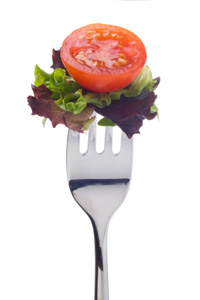 h needed color into
your diet. Start with a bed of greens, add vegetables, fruits, meats,
nuts, or cheeses for the ideal side dish, or the grand entrée itself. h needed color into
your diet. Start with a bed of greens, add vegetables, fruits, meats,
nuts, or cheeses for the ideal side dish, or the grand entrée itself.
In this issue, we
explore the variety of greens available and how best to handle them.
Then, we guide you through dressing your greens with the perfect
vinaigrette and seasoning the salad to taste. We finish with three
scrumptious green salads, each with a different taste and personality,
ready to grace your table and satisfy your taste buds.
|
Spring Super Sale
| 
|
|
|
|
Spin Up a Salad
| Once was the day when a
tossed salad meant iceberg lettuce garnished with a tomato wedge or two
and a few slices of cucumber. That scenario is ancient history. Farmers'
markets are full of alternatives and variations. Today's salads range
across dozens of leafy greens, wonderful individually, or as part of
complementary mixtures. As well, in the last few years packaged greens
have become popular, and now account for over 80% of leafy green produce
sales. This new way of presenting greens has benefited the consumer
with a greater variety of produce in fresh, usable portions.
Types of Greens - The plethora of
available greens gives us the opportunity for some new flavor
explorations, texture experimentation, and color excitement. Some greens
provide crunch better than others, some are mild in taste, others are
bitter.
Do Packaged, Pre-Washed Greens Need Washing?Yes! Despite the claims of "triple-washed" on the packaging, bagged
produce is subject to the same field and handling exposure as homegrown
greens. A recent study by Consumer Reports in March 2010 convinced us that
all greens need washing. The investigation studied 208 packages of
bagged greens from 16 brands. The results revealed that 39% of the
packages had unhealthy levels of bacterial contamination, (though none
had E. coli, salmonella, or listeria, some particularly potent
bacteria). The type of packaging, brand, or whether the greens were
organic or not, did not seem to influence the contamination pattern.
However, the fresher the greens, the less the contamination. The report
recommends three actions: (1) Choose the freshest greens, (2) Wash them,
and, (3) Keep greens away from raw meat to reduce cross-contamination.
Does Washing Really Help? Yes. Since
fresh salad produce is not cooked to bacteria-killing temperatures, it's
impossible to eliminate contamination with 100% surety. But, washing
can greatly reduce the quantity of contaminants, and, thereby, minimize
exposure to levels that our bodies are used to managing.
How to Wash Greens - By definition,
greens grow close to the ground and pick up dirt as they grow and as
rain splashes dirt on the leaves. Greens harvested from your garden, the
local farmers' market, or bagged from the supermarket all require
washing. The cold water bath will also help to freshen and rehydrate the
leaves.
|
Dress It Up
| Good greens like to dress up
for the occasion. As tasty as they are on their own, it's the marriage
of greens with dressing that make for the full salad experience. Salad
dressings can be generally classified into three types: (1) Vinaigrettes
(oil and vinegar-based), (2) Mayonnaise-based, and (3) Dairy-based
(sour cream, buttermilk, or cream). A great dressing provides an
essential layer of flavor in a concentrated form that accentuates the
salad and brings out the best of the fresh produce without overpowering
the moment. We'll focus here on vinaigrettes.
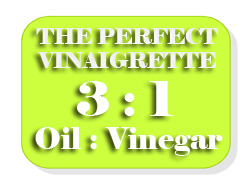 The Magic Ratio for
Vinaigrettes - We're fondest of oil and vinegar variations
because they allow the greens' flavor and appearance to shine on the
plate and in the mouth. Vinaigrettes sport an oil to vinegar ratio of
3:1, three parts oil for every one part vinegar. From this classic
formula, any number of combinations and additions serve to shape the
vinaigrette's personality. The Magic Ratio for
Vinaigrettes - We're fondest of oil and vinegar variations
because they allow the greens' flavor and appearance to shine on the
plate and in the mouth. Vinaigrettes sport an oil to vinegar ratio of
3:1, three parts oil for every one part vinegar. From this classic
formula, any number of combinations and additions serve to shape the
vinaigrette's personality.
Choosing
the Oil - Aficionados recommend using a neutral-to-lightly
flavored oil for salads. Neutral oils include canola, soy, or safflower
oil. 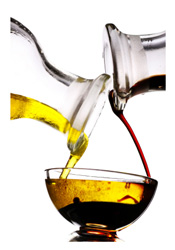 Our favorite,
of course, is olive oil. Use only extra-virgin olive oil, the oil from
the first pressing of the olives, for salads. The delicate flavor is a
perfect foil for most salads. Save strongly flavored oils such as
walnut, sesame, or chili, as accents in the dressing. Our favorite,
of course, is olive oil. Use only extra-virgin olive oil, the oil from
the first pressing of the olives, for salads. The delicate flavor is a
perfect foil for most salads. Save strongly flavored oils such as
walnut, sesame, or chili, as accents in the dressing.
What is Vinegar? - Vinegar is the
naturally occurring result of two fermentation processes. Sweet liquids
undergo a first fermentation process where yeast breaks down the sugars
into alcohol. The second fermentation uses Acetobacter bacteria to
breakdown the alcohol into acetic acid. To be a vinegar, there must be
at least 4% acetic acid in the liquid. 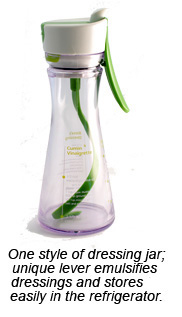 However, water and
acetic acid do not make vinegar; rather, it is the original fruit's
character, flavor, vitamins, and minerals that give vinegar its taste
and character. We are most familiar with vinegars made from apple juice
and grape juice, though any plant with sugars can become vinegar. For
example, malt vinegar, the British standard, is made from germinated
grain. However, water and
acetic acid do not make vinegar; rather, it is the original fruit's
character, flavor, vitamins, and minerals that give vinegar its taste
and character. We are most familiar with vinegars made from apple juice
and grape juice, though any plant with sugars can become vinegar. For
example, malt vinegar, the British standard, is made from germinated
grain.
Mixing Vinaigrettes- Oil and water don't mix, we know that. For salad dressings, the oil
and water is shaken or stirred enough so that a temporary emulsion is
achieved and salads evenly dressed. Three common kitchen tools make
great dressings: whisk, food processor, or blender. Our mini-food
processor is particularly nice for chopping the garlic and shallots
first prior to adding the vinegar and oil. 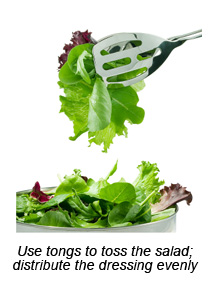 Whatever your
tool of choice, make the dressing in glass or stain-resistant plastic
containers with stainless steel utensils. Aluminum vessels and utensils
will react with the vinegar leaving a metallic taste. Mix all of the
dressing ingredients, except the oil, and blend thoroughly. Slowly
drizzle the oil into the vinegar base while whisking or processing. The
tiny hole in the feed tube of your food processor is made especially for
the gradual addition of oil. Whatever your
tool of choice, make the dressing in glass or stain-resistant plastic
containers with stainless steel utensils. Aluminum vessels and utensils
will react with the vinegar leaving a metallic taste. Mix all of the
dressing ingredients, except the oil, and blend thoroughly. Slowly
drizzle the oil into the vinegar base while whisking or processing. The
tiny hole in the feed tube of your food processor is made especially for
the gradual addition of oil.
Toss
and Serve - Immediately before serving, drizzle the dressing
over the freshly prepared greens. Ensure that the greens are dry or the
dressing will not adhere to the leaves' surfaces. With salad utensils,
toss so that all of the greens are evenly coated with the dressing. A
vinaigrette dressing has the effect of wilting the salad in a very short
time, so serve and enjoy immediately.
|
Season to Taste
| 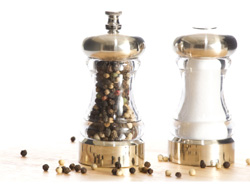 Green salads host the perfect
occasion for finishing with salt and pepper. Not only are salt and
pepper a great flavor addition, they add a visual touch and,
potentially, a little culinary performance art. Here are some quick
definitions and tips on "seasoning to taste." Green salads host the perfect
occasion for finishing with salt and pepper. Not only are salt and
pepper a great flavor addition, they add a visual touch and,
potentially, a little culinary performance art. Here are some quick
definitions and tips on "seasoning to taste."
Salt - This ubiquitous seasoning is
simple sodium chloride, yet comes in many forms that will impact your
cooking life:
Table salt -
This salt is very fine grained and is generally mined from salt
deposits. Table salt is available in iodized or non-iodized forms.
Unless specified otherwise, recipes calling for salt refer to table
salt. Kosher
salt - This salt is larger grained and typically without
additives. The larger grains do not dissolve as readily as table salt
providing certain advantages in various cooking situations. Because of
the larger grains, one teaspoon of kosher salt is half to one-third as
potent as one teaspoon of table salt. If substituting kosher salt,
measure by weight instead of volume. Sea salt - Derived from evaporated seawater,
sea salt has the advantage of micro-flavors from minerals of the
region. Specialty salts are perfect for finishing salads where they
willing bloom and are showcased to perfection. We'd be happy to walk you
through the different choices of finishing salts. 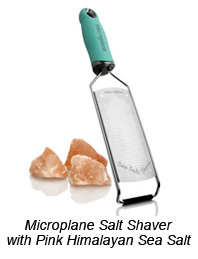
Pepper - Married with salt forever,
freshly ground pepper on a salad complements the greens and the
dressing. Unrelated to chili peppers, peppercorns are dried fruits that
when ground, release piperine compounds that stimulate our taste buds.
The potency of pepper evaporates quickly when exposed to air, so grind
peppercorns just before using.
Shakers,
Shavers, and Grinders - One of our favorite gifts for newlyweds
is a quality salt and pepper set. We have many choices that are truly
works of art ready to grace any table. Salt shavers are unique tools
that transform a chunk of salt into small flakes as a finishing step.
Never put salt in a pepper grinder, or vice versa - each device is
specially made for its designated contents.
|
Smart Green Salad Tips
| Tip #1:
When eating salad, proper etiquette allows for cutting larger
leaves or
vegetables into bite-sized pieces for easier eating. You may use the
side of the salad fork for cutting, or a fork and knife. 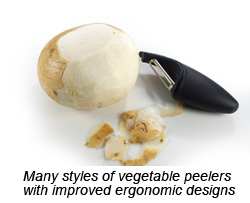 Do not cut the
entire salad at the onset, but cut bite by bite. Do not cut the
entire salad at the onset, but cut bite by bite.
Tip #2: Update your peeler!
There are so many new styles of peelers available, that it's worth a
renewed exploration of the genre. Many peelers feature ceramic blades
and ergonomic handles.
Tip #3:
Vinegar is magic throughout the home. Use white distilled vinegar to
clean your microwave. Combine 4 tablespoons of vinegar in 1 cup of
water. Bring the solution to a boil in your microwave and allow to sit
for a few minutes. The steam will soften and loosen any spatters, and
the vinegar will cut through any grease.
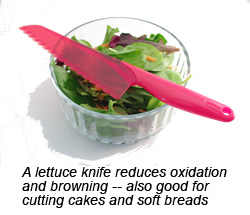 Tip #4:
A lettuce knife transforms any leafy head into manageable eating size.
But, its serrated edge also makes it useful for cutting cakes and softer
breads. A lettuce knife affords greater food safety by eliminating the
need to tear lettuce by hand. The special plastic blade avoids the
oxidation and browning inspired by a metal blade. Tip #4:
A lettuce knife transforms any leafy head into manageable eating size.
But, its serrated edge also makes it useful for cutting cakes and softer
breads. A lettuce knife affords greater food safety by eliminating the
need to tear lettuce by hand. The special plastic blade avoids the
oxidation and browning inspired by a metal blade.
Tip #5: The "Dirty Dozen" list
identifies fruits and vegetables that retain the most pesticides. The
ranking includes "lettuces" among the dirty dozen, with fresh spinach
lying just outside the cutoff. This information points us toward
choosing organic versions of greens.
|
Q & A's
|
 Q: Can I make my own flavored oils? Q: Can I make my own flavored oils?
A: Yes, but do so very cautiously.
Fresh herbs, garlic, or other flavor additions to oil contain water.
When immersed in oil, an anaerobic environment (no oxygen) is formed.
Naturally occurring bacteria can thrive in this situation, most notably
the bacteria responsible for the botulism toxin. Use impeccably clean
additions, refrigerate, and use within one week. We highly recommend
using commercially prepared flavored oils.
Q: What is balsamic vinegar?
A: Balsamic vinegar is a delicious,
nearly magical, form of vinegar that has been aged to perfection. There
are two types of balsamic vinegar, Aceto
Balsamico Tradizionale, and Condimento
Grade. The former begins with a reduction of grape juice to 30%
of its original volume. 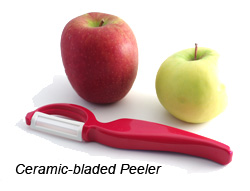 Like other vinegars,
the juice goes through fermentation processes, but differs from
everyday, "condimento grade"
balsamics by an aging process through a special sequence of different
wooden casks that may be 12, 18 or 25 years in length. True tradizionale balsamics are made only
in the Modena or Reggio Emilia regions of Italy and reflect their rarity
in their price point. Like other vinegars,
the juice goes through fermentation processes, but differs from
everyday, "condimento grade"
balsamics by an aging process through a special sequence of different
wooden casks that may be 12, 18 or 25 years in length. True tradizionale balsamics are made only
in the Modena or Reggio Emilia regions of Italy and reflect their rarity
in their price point.
Q: Why
are ceramic blades recommended when preparing produce?
A: Ceramic blades are made from
zirconia compounds fired at high temperatures. The result is a blade
that is chemically inert unlike a metal knife blade. Produce cut with a
metal knife will brown more quickly due to the interaction of metal
molecules with the fruit or vegetable; a ceramic blade will delay the
natural oxidation processes. Do the apple test - cut one apple with a
metal blade, another with a ceramic blade. Allow the apples to sit and
note the different speeds in browning.
Q: How long will vinegar last?
A: Because of its strong acidic
nature, vinegar will last indefinitely and does not require
refrigeration. The environment is inhospitable to bacteria and sports an
acidity of between 4 - 7%. |
Cookbook Review
| Simply Salads by Jennifer
Chandler. Photography by Langdon Clay. Published by Rutledge Hill Press,
a division of Thomas Nelson, Inc., Nashville, TN. Copyright 2006.
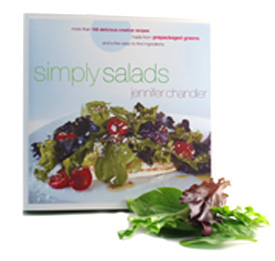
This
has quickly become one of our favorite salad cookbooks. The book is
premised on pre-packaged lettuce mixtures. With these readily available
greens, any number of salad combinations is quickly accessible. Ms.
Chandler sets the scene with a brief explanation of greens and
definitions of the common mixtures. From there she offers chapters of
delicious salads based on just greens, then greens paired with poultry,
meat, seafood, vegetable, fruits, and grains. Each recipe is matched
with the perfect complementary dressing. The recipes create easy
elegance as an everyday routine for the salad plate. There's a summer's
worth of great salads ahead with this book in your hand.
|
Simply Great Green Salad Recipes
| Recipes excerpted from Simply Salads
by Jennifer Chandler. Published by Rutledge Hill Press, a division of
Thomas Nelson, Inc., Nashville, TN. Copyright 2006. Reprinted with
permission of the publisher. All rights reserved.
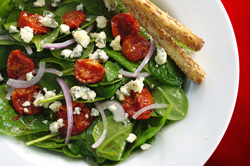 Spinach Salad with
Roasted Cherry Tomatoes Spinach Salad with
Roasted Cherry Tomatoes
with Balsamic Dijon Vinaigrette
View and Print
Tender baby spinach
leaves are some of our favorite greens. In this salad, roasted cherry
tomatoes provide a concentrated flavor burst and are simple to make. A
few thinly sliced red onions and a generous crumble of blue cheese
completes the salad. A balsamic vinaigrette ties the experience
together.
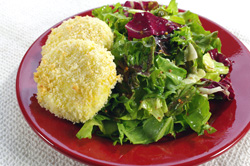 Warm Goat Cheese
Salad Warm Goat Cheese
Salad
with Grainy Mustard Vinaigrette
View and Print
Romaine and iceberg
pair with the slight bitterness of endive and radicchio to set the
backdrop for this salad. Medallions of goat cheese are covered with
breadcrumbs and toasted to golden perfection. The vinaigrette, spiked
with whole-grain mustard, complements both the greens and the warmed
cheese.
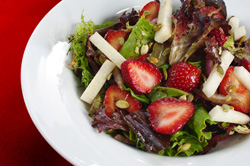 Hot Chili Oil Salad Hot Chili Oil Salad
with Hot Chili Oil Vinaigrette
View and Print
This salad packs some
cool heat in every bite. A fresh mixture of spring greens is ornamented
with sliced, red-ripe strawberries with plenty of crunch from
matchsticks of jicama and thin slices of red onion. The dressing brings
it all to life with a mixture of chopped fresh herbs and a liberal dose
of hot chili oil.
|
|
Dress up some fresh spring
greens and make a great salad!
|
|
Lorraine, Katie, and all of the Staff at Beyond Pots and Pans
|
|
|
|
|